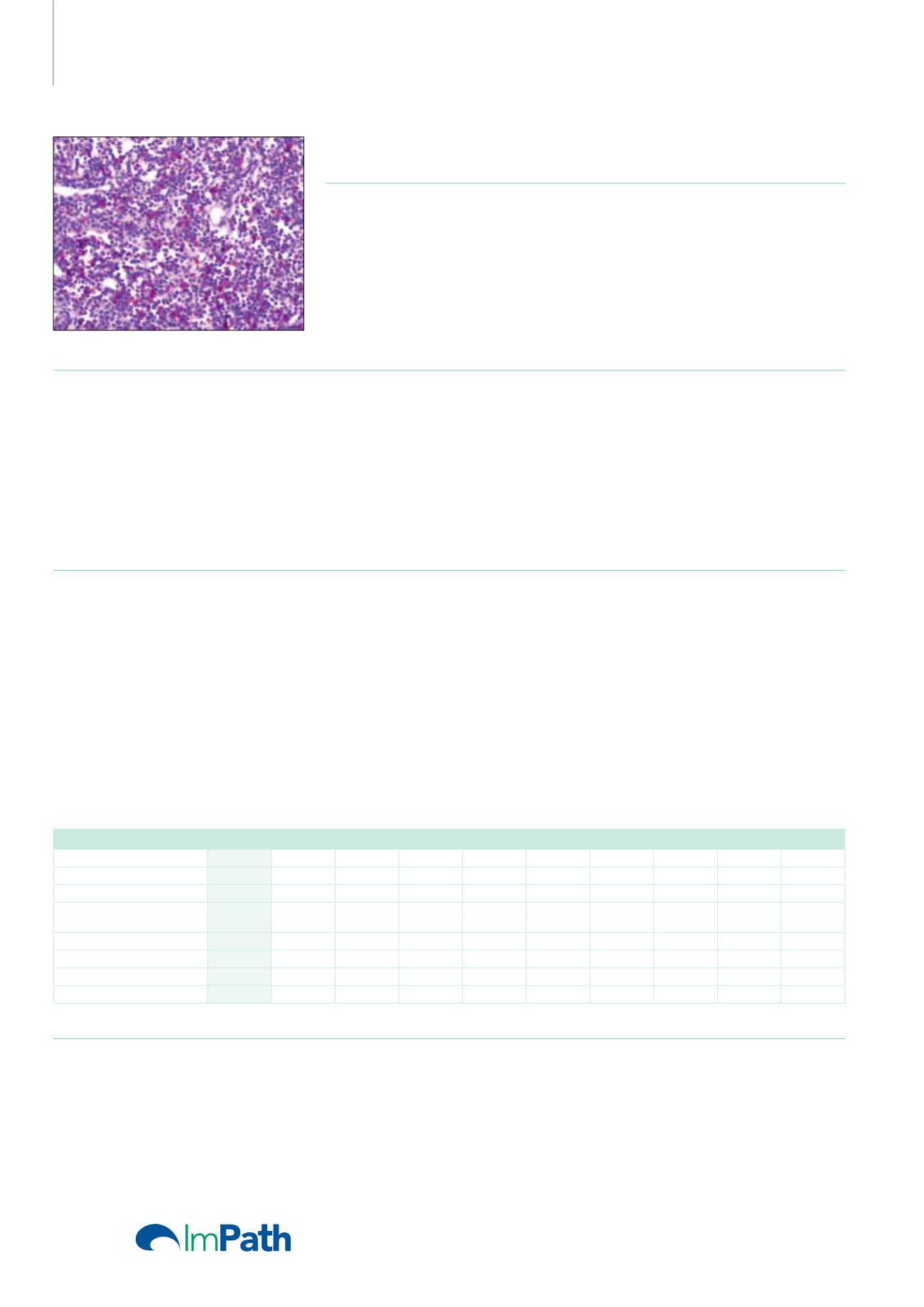
Antibodies for
Immunohistochemistry
CD8 (C8/144B)
Mouse Monoclonal Antibody
Cat. No. Description
Volume
45191 IMPATH CD8 RTU M (C8/144B)
50 Tests
44254 CD8 RTU M (C8/144B)
7 ml Ready To Use
44529 CD8 0,1 M (C8/144B)
100 µl liquid Concentrated
44530 CD8 1 M (C8/144B)
1 ml liquid Concentrated
Product Specifications
Designation
IVD
Reactivity
Paraffin
Visualization
Membranous
Control
Tonsil
Stability
Up to 36 mo. at 2-8°C
Isotype
IgG
1
/k
Manual Protocol*
• Pretreatment: Heat Induced Epitope
Retrieval (HIER)
• Primary Antibody Incubation Time:
10-30min @ 25-37°C
• 2-step polymer detection
*Please refer to product insert for complete protocol.
ImPath Protocol*
• Dewax: Dewax Solution 2 (DS2)
• Pretreatment: Retrieval Solution pH 9.0
(TR1) 32min @ 98-103°C
• Primary Antibody Incubation Time:
10-90min @ 25-37°C
• HRP Polymer (Universal) or AP Polymer
(Universal) for 12 min
*Please refer to product insert for complete protocol.
Product Description
The CD8 (cluster of differentiation 8) antigen is a cell surface glycoprotein found on most cytotoxic T-lymphocytes that mediates efficient cell-cell
interactions within the immune system. CD8 is a transmembrane glycoprotein that serves as a co-receptor for the T-cell receptor (TCR). TCR is
a heterodimer composed of either α and β or γ and δ chains. CD3 chains and the CD4 or CD8 co-receptors are also required for efficient signal
transduction through the TCR. The TCR is expressed on T-helper and cytotoxic T-cells that can be distinguished by their expression of CD4
and CD8 respectively. CD8 binds to a major histocompatibility complex (MHC) molecule, but is specific for the class I MHC protein. A primary
function of CD8 is to facilitate antigen recognition by the TCR and to strengthen the avidity of the TCR-antigen interactions. The CD8 coreceptor
is predominantly expressed on the surface of suppressor and cytotoxic T-cells at a low level by NK cells, large granular lymphocyte leukemia,
and some T-ALL/T-LBL.
For mature T-cells, CD4 and CD8 are mutually exclusive, so anti-CD8, generally used in conjunction with anti-CD4, is a useful marker for
distinguishing helper/inducer T-lymphocytes, and most peripheral T-cell lymphomas (CD4+/CD8-). Anaplastic large cell lymphoma is usually
CD4+ and CD8-, and in T-lymphoblastic lymphoma/leukemia, CD4 and CD8 are often co-expressed. CD8 is also found in littoral cell angioma
of the spleen.
T-cell Lymphomas
CD8
CD45
CD2
CD3
CD4
CD5
CD7
CD25 CD45RO PD-1
Angioimmunoblastic
-
+
+
+
+
+
+
+
+
+
Lymphoblastic
+/-
+
+/-
+
+/-
+
+
+
+
-
Subcutaneous
Panniculitis-Like
+/-
+
+
+
-
+
+
-
+
-
NK
-
+
+
+
-
-
-/+
+
+
-
Cutaneous
-
+
+
+
+
-
+
-
-
-/+
Peripheral, NOS
-/+
+
+
+
+/-
+/-
+/-
+
+
-
Mycosis Fungoides
-
+
+
+
+
+
-
+
+
-
Reference
1. Rossi ML, et al. J Clin Path. 1988; 41:314-319.
2. Stein H, et al. Adv Cancer Res. 1984; 42:67-147.
3. Phan-Dinh-Tuy F, et al. Mol Immun. 1982; 19:1649-1654.
4. Mason DY, et al. J Clin Pathol. 1992; 45:1084-8.
5. Nuchols JD, et al. J Cutan Pathol. 1999; 26(4):169-75.
50


